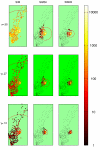The effect of travel restrictions on the spread of a moderately contagious disease
- PMID: 17166291
- PMCID: PMC1764026
- DOI: 10.1186/1741-7015-4-32
The effect of travel restrictions on the spread of a moderately contagious disease
Abstract
Background: Much research in epidemiology has been focused on evaluating conventional methods of control strategies in the event of an epidemic or pandemic. Travel restrictions are often suggested as an efficient way to reduce the spread of a contagious disease that threatens public health, but few papers have studied in depth the effects of travel restrictions. In this study, we investigated what effect different levels of travel restrictions might have on the speed and geographical spread of an outbreak of a disease similar to severe acute respiratory syndrome (SARS).
Methods: We used a stochastic simulation model incorporating survey data of travel patterns between municipalities in Sweden collected over 3 years. We tested scenarios of travel restrictions in which travel over distances >50 km and 20 km would be banned, taking into account different levels of compliance.
Results: We found that a ban on journeys >50 km would drastically reduce the speed and geographical spread of outbreaks, even when compliance is < 100%. The result was found to be robust for different rates of intermunicipality transmission intensities.
Conclusion: This study supports travel restrictions as an effective way to mitigate the effect of a future disease outbreak.
Figures




References
Publication types
MeSH terms
LinkOut - more resources
Full Text Sources
Medical
Miscellaneous

